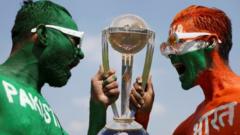In the heart of cricketing fervor, India's clash with Pakistan has long been hailed as cricket's greatest rivalry, steeped in rich history and national pride. The release of the Netflix documentary "The Greatest Rivalry: India v Pakistan" reignites discussions around this iconic matchup, often painted with the backdrop of political tension and sportsmanship.
Reflecting on its significance, cricket legends like Virender Sehwag and Waqar Younis offer differing perspectives, with some considering it a contest transcending mere sports. However, a recent crushing defeat of Pakistan at the Champions Trophy raises questions: is this legendary rivalry now driven more by historical narrative than competitive merit?
India's dominance in recent years—winning six of the last eight ODIs—has led to headlines like "a cricket war just a big yawn," questioning the essence of the rivalry. Critiques from Pakistani outlets highlight a lack of competitive spirit from their team, suggesting that ongoing political tensions could be the only binding force in this long-standing relationship. The consistent defeats have painted a bleak picture for Pakistani cricket, with concerns over isolation, administrative instability, and a declining talent pool.
Conversations surrounding the competition's status consider the staggering financial implications of these matches. Facing obscurity might be detrimental to the allure of this once-feared rivalry, especially as India raises its game with robust domestic support and the lucrative IPL, while Pakistani players remain absent from this financial ecosystem.
Commentators note that the initial allure of the rivalry, once encapsulated by fierce cricketing battles, has shifted towards a spectacle enhanced by media hype and commercial interests. Despite India's ascendancy, cricket enthusiasts maintain a robust demand for these encounters, with sellout crowds and record-breaking viewership figures when these nations face off.
In the end, while passion still fills the stands and screens, it remains to be seen if the rivalry can reclaim its intensity or if it continues as an unbalanced contest fueling more imagination than actual competition. As Shubman Gill aptly puts it, "If so many people are happy to watch the match, then who are we to say it is underhyped or overhyped," challenging observers to reassess their perspectives on this historic sporting clash.
Reflecting on its significance, cricket legends like Virender Sehwag and Waqar Younis offer differing perspectives, with some considering it a contest transcending mere sports. However, a recent crushing defeat of Pakistan at the Champions Trophy raises questions: is this legendary rivalry now driven more by historical narrative than competitive merit?
India's dominance in recent years—winning six of the last eight ODIs—has led to headlines like "a cricket war just a big yawn," questioning the essence of the rivalry. Critiques from Pakistani outlets highlight a lack of competitive spirit from their team, suggesting that ongoing political tensions could be the only binding force in this long-standing relationship. The consistent defeats have painted a bleak picture for Pakistani cricket, with concerns over isolation, administrative instability, and a declining talent pool.
Conversations surrounding the competition's status consider the staggering financial implications of these matches. Facing obscurity might be detrimental to the allure of this once-feared rivalry, especially as India raises its game with robust domestic support and the lucrative IPL, while Pakistani players remain absent from this financial ecosystem.
Commentators note that the initial allure of the rivalry, once encapsulated by fierce cricketing battles, has shifted towards a spectacle enhanced by media hype and commercial interests. Despite India's ascendancy, cricket enthusiasts maintain a robust demand for these encounters, with sellout crowds and record-breaking viewership figures when these nations face off.
In the end, while passion still fills the stands and screens, it remains to be seen if the rivalry can reclaim its intensity or if it continues as an unbalanced contest fueling more imagination than actual competition. As Shubman Gill aptly puts it, "If so many people are happy to watch the match, then who are we to say it is underhyped or overhyped," challenging observers to reassess their perspectives on this historic sporting clash.


















